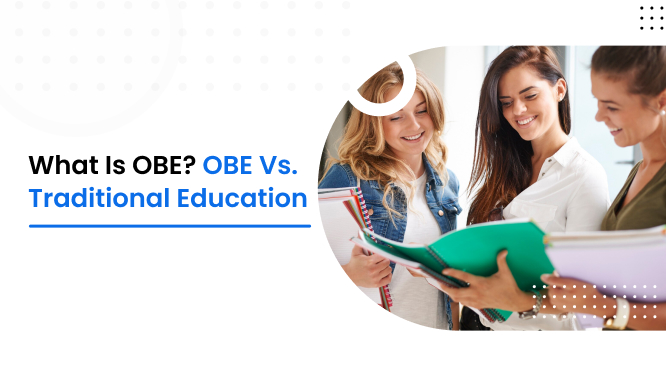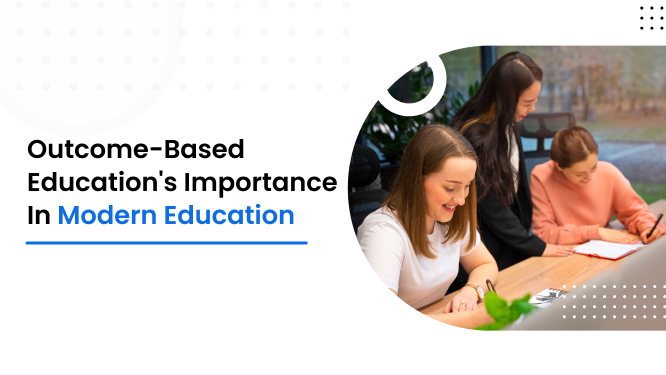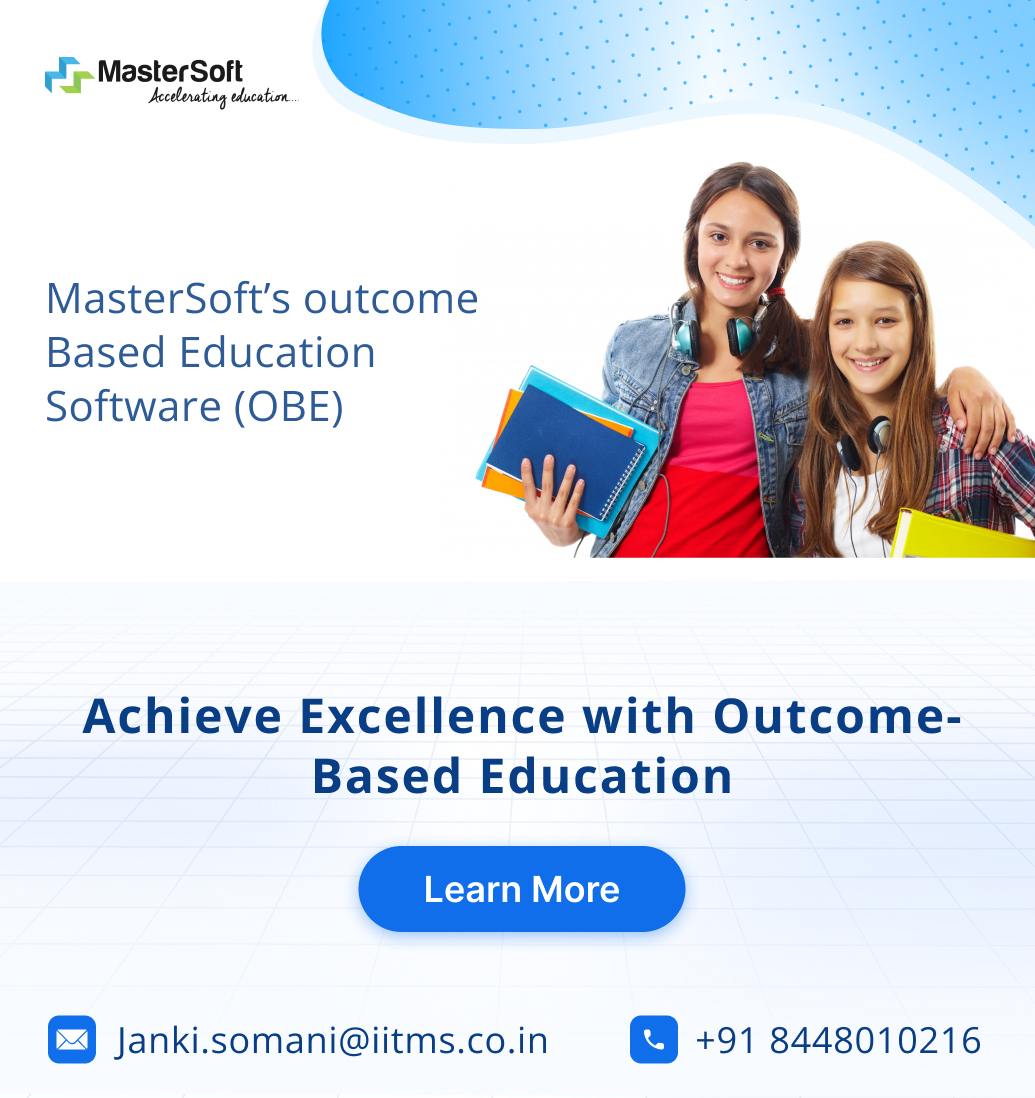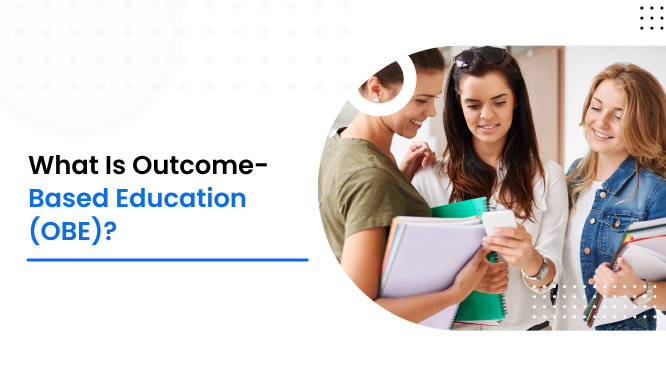
Discovering Outcome-Based Education (OBE)?
Which educational approach is the best for students? This is a common question that many educators and institutes ponder. There is no definitive answer because what might work for one student might not be applicable to others.
Nevertheless, student-centricity, goal-orientedness, and strategic steps must take precedence in the instructional approaches. Hence, outcome-based education is an ideal educational technique that motivates learners to stay on track and achieve predetermined goals.
It highlights the specific skills and knowledge students should attain by the end of the program or course. It is one of the sought-after approaches due to the underlying systematic framework; hence, it is only fitting to take an in-depth look.
What is outcome-based education?
Outcome-based education is a unique educational methodology that specifies particular learning outcomes. It encourages the development of teaching and learning practices to attain the established outcomes.
It is in stark contrast to the traditional educational system, which focuses more on syllabus completion and examination. In fact, outcome-based education prioritizes measuring the knowledge, skills, and capabilities that learners must attain by the end of the course.
Also, identifying the learning outcomes is the first step in the process, which includes the information and abilities that learners succeed at demonstrating by the course’s end. The next step involves careful planning of the curriculum, teaching methods, and assessments.
It is an evidence-based approach, which means that it has shown positive results in terms of academic and overall development. The long-term advantage of an outcome-based educational approach is due to its core features.
Core Features of Outcome-Based Education
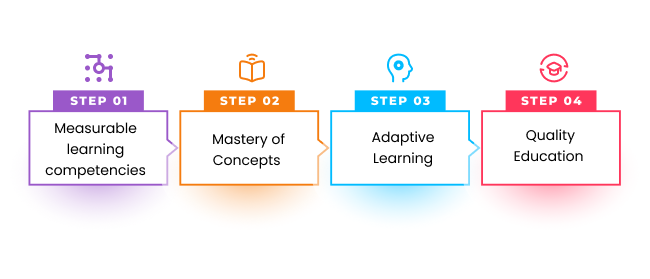
Measurable learning competencies
The unique educational method defines the learning competencies or outcomes that students must achieve by the end of the program. It focuses on students’ factual knowledge, ability to demonstrate their skills, and understanding of critical concepts.
Teachers use verbs to emphasize the learning outcomes in different domains, such as:
- Students will be able to identify and explain the causes of World War I.
- Students will be able to develop a blueprint for a generator.
Mastery of Concepts
As opposed to the traditional educational system that rushes through topics and syllabuses, OBE focuses on mastery of concepts. Teachers use a rubric or standard to assess whether or not students have gained an in-depth understanding of core concepts.
It creates a self-paced learning environment wherein students don’t have to worry about keeping up with the rest of the class’s pace. It helps them understand concepts effectively and apply them in practical scenarios.
Adaptive Learning
OBE adopts a flexible system of teaching and learning wherein teachers can integrate different methods to cater to students’s needs. Therefore, students can choose learning paths according to their preferences and learning styles.
For instance, teachers can use blended learning, wherein they can combine in-class instruction with online learning modules. Likewise, they can use essays, presentations, and personalized assessments to accommodate different learners.
Quality Education
Rote memorization and exam centricity are two flaws that are central to the traditional education system, which contributes little to nothing to the student’s learning experience. However, OBE’s well-designed methodologies empower students to learn effectively.
In fact, they succeed at learning critical thinking abilities and problem-solving capacities and applying them in real-world scenarios. As a result, they are able to handle diverse problems and develop creative solutions accordingly.
Steps to Implement Outcome-Based Education
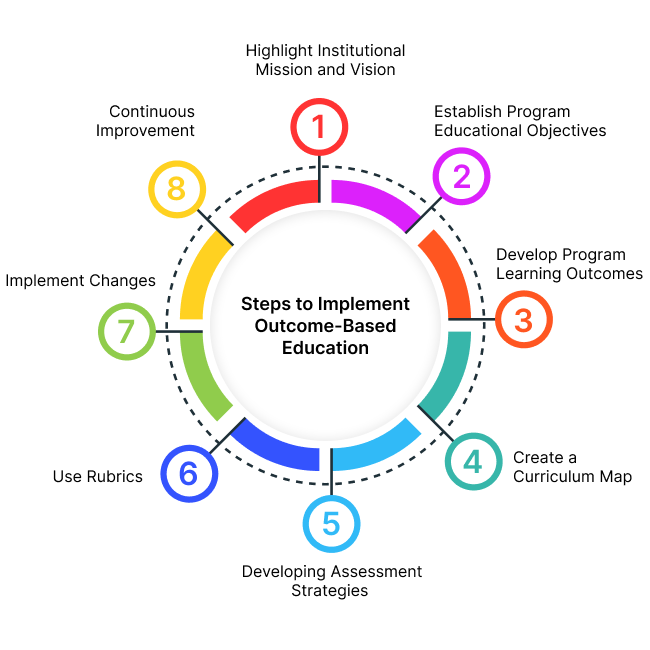
A well-planned framework forms the foundation of any educational methodology, which includes essential steps such as the following:
Highlight Institutional Mission and Vision
Developing institutional mission and vision statements is one of the initial tasks that highlights the aspirations of the educational institute. Besides, these statements align with the respective goals that colleges and universities want to achieve in the long run.
- Vision Statements: They describe an institute’s ambitions for the future and the impact it wants to have on its students. Also, these statements are usually ambitious and idealistic.
Example of a Vision Statement: To be an outstanding center for research and innovation, helping to produce solutions to crucial issues.
- Mission Statements: They describe the primary purpose of an institute and the specific actions it takes to achieve its vision.
Example of Mission Statement: To provide an enriching educational experience to all students that improves critical thinking and communication skills.
Establish Program Educational Objectives
Program educational objectives (PEOs) refer to broad statements that describe the professional and career goals that students must attain within a specific timeframe. Furthermore, they indicate a long-term impact of the program on the student’s professional lives.
Therefore, PEOs are future-oriented, describing the competencies or capabilities that they can show in the future. They entail a wide range of skills and knowledge, which enables them to function effectively in their chosen fields.
Also, they must align with the student learning outcomes; hence, getting input from faculty, alumni, and other stakeholders helps to develop relevant PEOs.
Develop Program Learning Outcomes
Program learning outcomes (PLOs) are measurable statements that relate to knowledge, skills, and capabilities that students achieve after completing a program. Therefore, avoiding technical jargon and using action verbs to write the statements is an ideal strategy.
For example, teachers can refer to Bloom’s Taxonomy to develop PLOs, helping to highlight the specific knowledge and skills within the program. However, the focus must be on what the students will learn rather than the attributes of the program.
For example, students will be able to develop and implement algorithms and solve programming problems.
Create a Curriculum Map
How can teachers ensure that they have covered all the core topics? How do you ascertain the connection between PEOs and PLOs? Addressing and answering these questions is important to monitor the overall progress of the course, program, and students.
Furthermore, a curriculum map can be a spreadsheet, table, chart, or mindmap; it depends on the educator’s preference. It must include the following features:
- Topics or Units: The primary themes or focus areas of the program.
- Learning Objectives: Particular measurable goals according to each topic and area.
- Instructional Methods: teaching methodologies and pedagogies that teachers use within the classroom, helping students attain objectives.
- Assessments: evaluation techniques and strategies that teachers use to assess student learning and individual progress.
- Timeline: A timeframe for exploring each topic within the program’s schedule.
Developing Assessment Strategies
One of the main objectives of outcome-based education is to ensure the development of all students. Therefore, employing outdated assessment techniques is ineffective as it serves to assess subject-related knowledge.
On the contrary, implementing different types of assessment techniques helps measure student achievement in terms of learning outcomes. Some of the effective assessment techniques include:
- Individual or group projects: These allow learners to research, plan, and develop projects that showcase their understanding and application of skills.
- Presentations: Students present their findings, solutions, and analyses.
- Self-Assessment and Peer Review: Learners reflect on what they have learned so far, helping to identify areas of strength and weakness. On the other hand, peer reviews provide a chance to exchange constructive feedback with each other.
Use Rubrics
Rubrics are useful tools as they provide clear guidelines for students and teachers and help them identify quality performance with regard to learning outcomes. The first step in building a rubric includes recognizing the key criteria relating to different aspects of students’ performance.
The second step includes establishing precise performance levels for each criterion; the levels can range from "unsatisfactory" to "exemplary" and describe the quality of work. Also, using clear and concise language to describe the different performance levels is important.
Implement Changes
Flexibility is a crucial feature of OBE, making it feasible for teachers to use different approaches whenever a particular technique does not work out. It includes updating the program strategy according to the learning requirements.
Likewise, teachers can use a different assessment method if a particular method does not align with student learning outcomes.
Continuous Improvement
Outcome-based education is an ongoing process that requires ongoing evaluation through different mechanisms. Educators and institutes ensure continuous improvement through the following process:
- Data Gathering: Teachers collect student performance-related data regularly through surveys, assessments, and feedback mechanisms.
- Results Analysis: Analyzing the data to point out areas where students have been doing well and areas for improvement.
Moreover, educators use the data to re-evaluate and refine the learning outcomes, ensuring that they are relevant to the program goals. Likewise, they modify the curriculum content, teaching methods, and learning activities depending on students’ activity data.
In Conclusion,
Outcome-based education is a strategic pedagogical approach that utilizes various methods to improve student's capabilities. It focuses on the overall development of students and enhances their skills, knowledge, and capabilities.
It is one of the most prominent educational techniques because it helps to address varied student learning needs and helps to attain learning outcomes.
